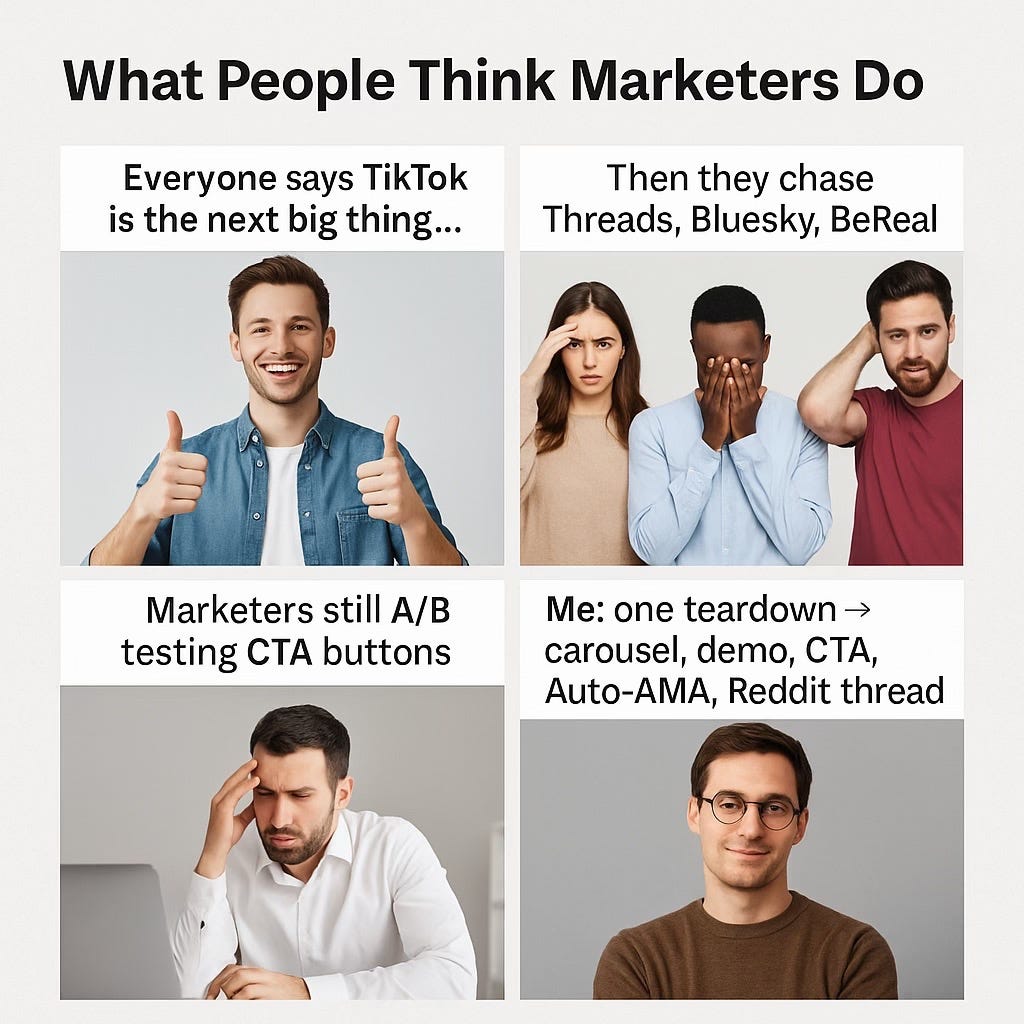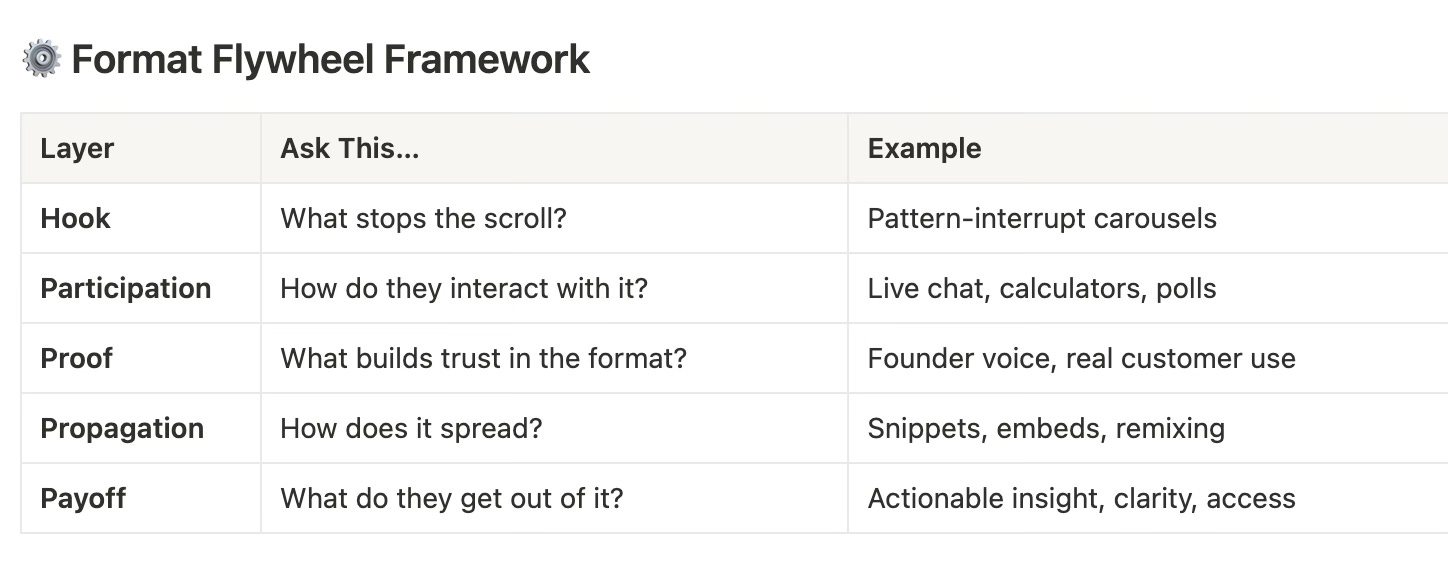Stop Chasing Channels. Start Crafting Formats.
Everyone’s in the same inboxes, fighting over the same tired feeds, remixing the same templates from 2019. So the obvious question becomes: What’s left?
Every marketing channel sucks right now
said “Every marketing channel sucks right now.”
And yeah — he’s not wrong. Everyone’s in the same inboxes, fighting over the same tired feeds, remixing the same templates from 2019. Somehow still thinking it’ll break through? That’s delulu, babe.
So the obvious question becomes: What’s left?
And if you’re like me, this is the part where your brain politely suggests “carrier pigeons” or “fax campaigns” - because surely we’ve run out of options, right?
But actually, no.
There’s still leverage hiding in plain sight.
Because while the channels might be loud, formats — the how behind the message — still give you room to play.
Same tools. Same audience. Different outcomes.
An email doesn’t have to be ignored — it could be a Notion walkthrough someone actually forwards.
A LinkedIn post doesn’t have to disappear into the scroll — it could be a teardown that gets shared in Slack and sparks demo requests.
Even a product demo doesn’t have to feel like homework — it could be an instant, no-login tour that does the selling before sales even shows up.
The difference? Not the channel. The format.
And that’s what we’re getting into next:
Real formats that are actually working — and how teams are using them to stand out without chasing whatever platform’s trending this week.
Why Formats Matter More Than Channels
Channels used to be the edge. Being early to LinkedIn, paid social, or even SEO gave you leverage. But now? Everyone’s everywhere. The playing field is flat - and crowded. What used to be a competitive advantage is now just the minimum.
That’s why format matters more. Because how you show up is the only part that’s still uniquely yours. Same post, same inbox, same feed — but a teardown, a behind-the-scenes walkthrough, or a sharp carousel lands very differently than yet another “quick thought” thread.
As
puts it, “Products are built to fit with channels. Channels do not mold to products.”
It’s the same with formats. You can’t force attention — you have to earn it with delivery that fits how people actually consume.
Format-First Plays That Still Win in 2025
Let’s get honest: most marketing formats age like milk — fast, sour, and with a weird aftertaste if you let them sit too long.
But a few? They evolve.
When executed with clarity, speed, and specificity — they cut through the noise and build momentum.
Here’s my take on what’s still working, what’s just getting started, and what’s criminally underused (especially if you’re an AI startup trying to stand out).
Live Founder Teardown Series
Nothing says “trust us with your GTM strategy” like watching someone sweat through a homepage audit on a Tuesday morning Zoom. But somehow, it works. Maybe that’s the point.
Real-time breakdowns of funnels or prompt flows are the new keynotes — punchier, raw, and way more clickable. Bonus points if you fix the mess live, using your own tool. Yes, it’s terrifying. That’s why it lands.
Strategic Partnerships That Actually Multiply
Some of the highest-leverage plays I’ve pulled off didn’t come from new channels — they came from the right partnerships. A well-matched tool, a smartly bundled offer, and a co-hosted session with actual value?
It can feel like a growth cheat code. I’ve seen prompt swaps, AI workflows, and demo bundles outperform entire outbound sequences. But it only works if the alignment is real. That means clear positioning, shared audience logic, and someone (ideally not me) keeping the Notion doc updated.
When it clicks, it scales. Just be ready to juggle landing pages, CTAs, post-webinar follow-ups, and at least one brand team’s “tiny feedback.”
Interactive Embedded Demos
“Book a demo” is the new “check out our whitepaper.” Static, slow, and completely ignorable. Cutting edge startups let you touch the product before you talk to sales. Click-through, no login, straight into the magic.
If you’re not building this, you’re asking people to imagine value. Spoiler: they won’t.
AI-Powered Demo Toolkits
If your product is built on AI and your demo still looks like a 2016 screencast… why? Tools like Arcade are making it embarrassingly easy to storyboard and narrate flows.
If you’re building smart tools, the way you show them should reflect that — or at the very least, show that someone on your team knows how to use them with a bit of imagination.
Reddit Community Formats
Everyone says they’re “community-led” until it’s time to actually show up in the community. Reddit isn’t just for gaming threads and chaos anymore — it’s becoming a high-trust space for bottom-funnel buyers, and it’s indexed by Google andLLMs. If you can’t be helpful there, you probably won’t be helpful in the inbox either.
Creator-Led Micro-Explainers
Influencer marketing for SaaS used to mean 20-minute tech reviews on YouTube with zero emotion. That’s over. Now it’s a 2-minute raw screen-record with commentary like “honestly I didn’t expect this to work.” And somehow, that sells better.
Why? Because creators have what you don’t: trust and reach with a specific community. Borrow both.
Vertical-Niche Content
Here’s a wild idea: talk directly to the exact people you want to sell to. “AI for HR teams with no time to prompt-engineer” beats “AI automation for modern teams” every single time. The deeper you go, the more creative freedom you unlock. Specificity isn’t limiting - it’s liberating.
AI Repurposed Content Kits
I love this one because it saves your team from content burnout and proves you understand distribution. Start with one good piece of thinking, then let AI stretch it across formats: a blog, a carousel, a 45-second clip, a CTA for outbound. That’s not “repurposing.” That’s building leverage.
Prompt Libraries & Mini-Challenges
People don’t believe your AI works until it solves their problem. Prompt libraries give them a head start. Mini-challenges? Even better.
Make it a game: “Can our AI write a better onboarding email than your intern?” Spoiler: yes. But let them discover that on their own.
Build-in-Public Founder Logs
Transparency isn’t a virtue signal. It’s a strategy. Especially in AI, where trust is still earned. I’ve seen founders win loyal early users just by sharing bugs they fixed and prompts that failed. No polish, just presence. Build in public — and people will root for you.
AI-Repurposed Content Kits
This one’s pure leverage. You start with one solid idea — a product insight, a teardown, a hot take — and let AI spin it into multiple formats: a short video, a carousel, a blog draft, maybe even a few cold outbound hooks. I’ve used this to test tone, find traction, and avoid the “one-and-done” trap. It’s not about flooding channels. It’s about giving the same idea more ways to land.
Channels are distribution. Formats are differentiation.
The 5-Part Format Check We Use Before Hitting Publish
(Because vibes aren’t a strategy)
Before anything goes out — a post, a demo, a live session — me and the team give the format a quick gut check. Not in a big process-heavy way, just five fast filters we’ve come to trust.
It helps us catch the difference between “this looks fine” and “this could actually land.”
The goal isn’t to be perfect — it’s to avoid publishing something that relies entirely on the channel doing the heavy lifting. Because channels are noisy. But if the format has a hook, gives people something to do, earns some trust, and delivers a clear payoff? It tends to work harder, longer, and better than we expect.
This check has saved me from approving forgettable work more than once.
And when everything lines up — it’s usually the format, not the channel, that made it win.
⚙️ Format Flywheel Framework
Vibes aren’t a strategy. Before you publish anything — a teardown, a demo, a carousel - you need to know if the format can actually carry the weight.
That’s where this framework comes in.
The Format Flywheel helps you gut-check your creative before it hits send: Is there a hook? Will anyone interact? Does it earn trust? Can it spread? And most importantly — what’s in it for the audience?
When these five layers click, the format pulls its weight. When they don’t, no channel can save you.
Why Format Still Works — Even If Everything Else Is on Fire
I didn’t get into marketing just to run A/B tests and optimize conversion paths. I got into it because I liked the idea that one message — said well, delivered right — could shift how people think, act, or decide. From a small town in Europe, that felt like a kind of superpower.
Years later, not much has changed. Except now, we’re all flooded with content. Everyone’s running the same plays. Every channel feels maxed out.
But format — how we show up — is still where the difference happens.
It’s not just about reach. It’s about resonance.
That’s why format still works. Even now. Especially now.



